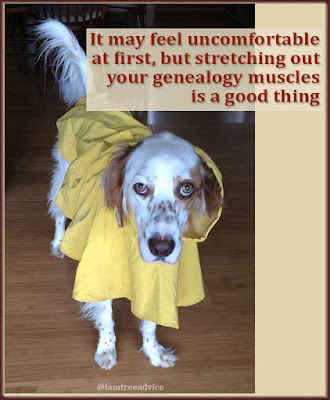Getting pretty good at genealogy? Try working with a new set of records.
I tend to write this blog about what I'm doing in genealogy at the moment. It's a great system, actually. I have to play around in genealogy every day to keep the blog going.
What I'm doing right now is stretching my skills by helping other people with their family trees. I specialize in Italian ancestry. So I'm offering to:
- locate Italian vital records
- translate them, and
- piece together families for my customers.
If you've been working on your own family tree for a while, you're probably in your genealogy comfort zone. You're locating government documents from your own country, like:
- census records
- immigration and naturalization records
- vital records
- military records, and more
The documents are often very similar, so you get comfortable with them. You know where to look on a census sheet for the head of household's occupation. You know where to look on a death record for the names of the deceased's parents.
 |
| Things can get so easy they start to bore you. There's a lot more to genealogy. |
Now imagine suddenly diving into a pool of different documents. They can be so…different. It can throw you off your genealogy game a bit.
All my ancestors came from neighboring towns in Italy. Each town's birth, marriage, and death records are pretty similar to one another. I know exactly how to handle my towns' documents and extract what I need from them.
But in different regions of Italy, the pre-printed forms can vary a lot. The father's name on a birth record may not be where I expected. The baby's name may be written very large (that's great!) or small and blended into the paragraph (harder to spot).
What I'm finding right away is that we can learn and adapt quickly.
I hope you'll get ambitious and start to explore a branch of your family tree you haven't touched before. You may find that documents from their country are different than what you're used to.
Don't get worried. All you need to do is get settled in. Here are the 2 main tips for dealing with dramatically different documents.
1. Learn Some of the Language
If you're going to gather documents from a new country, you need to learn a handful of words in their language. I'll be working with all Italian documents, but eventually I may need to learn the dreaded Latin.
Whenever you need to dig into foreign-language documents, you must learn the keywords.
Say you're viewing a birth record. You need to know the words for born, husband, wife, the days of the week, months of the year, and numbers. Memorize those months and numbers. FamilySearch.org offers a list of all the important keywords in a bunch of languages. See What Language Barrier?
You can do this!
 |
| You've learned so much already. Stretch yourself and see how much more you can master. |
2. Recognize the Key Facts
When I'm looking at a really old Italian document, it's all hand-written. There is no pre-printed, easy-to-read form. But I don't get overwhelmed. I find a key fact and dive right in.
A very old birth record often begins with details about the volume where you can find the record. It may include the beginning and ending dates covered by that volume. I don't need all that.
The first thing I look for on an old birth record is the word comparso. That means appeared. The recorder of the document is saying so-and-so appeared before me, the mayor or town official.
The person who appeared is either the father of the new baby or the midwife. In rare cases it's the grandfather of the baby or another relative. But by and large, it's the baby's daddy. So I find comparso and read what follows. It should be a name and an age. If it's a man's name, like Antonio delGrosso, and he's about 28 years old, that sure sounds like he's the father. If he's 68 years old, I'll check to see if he's the grandfather.
Now that I found that important entry point, it's easier to decipher what's next. I expect to find:
- when the baby was born
- the mother's name
- whether she is "Antonio delGrosso's" legitimate wife
- the baby's given name.
If the birth record format for a particular town is different than my towns, I know I can adjust. I like to page through the documents, looking for a particular last name. I keep my eyes only in the part of the page where it says a name after the word comparso.
I can flip through the documents, looking at that one spot, and stop only when I see the name I want. Only then will I read the rest of the document.
If you have a multi-ethnic background, you may have dabbled in a few countries already. But I'll bet a lot of you haven't ventured outside your own country yet. Don't be afraid! You can get used to anything.
Step out of your genealogy comfort zone and expand it. It's not hard once you get settled in.
No comments:
Post a Comment
You may leave an anonymous post if you have no Google account. The author screens each comment for spam before it appears here. So don't bother to spam.